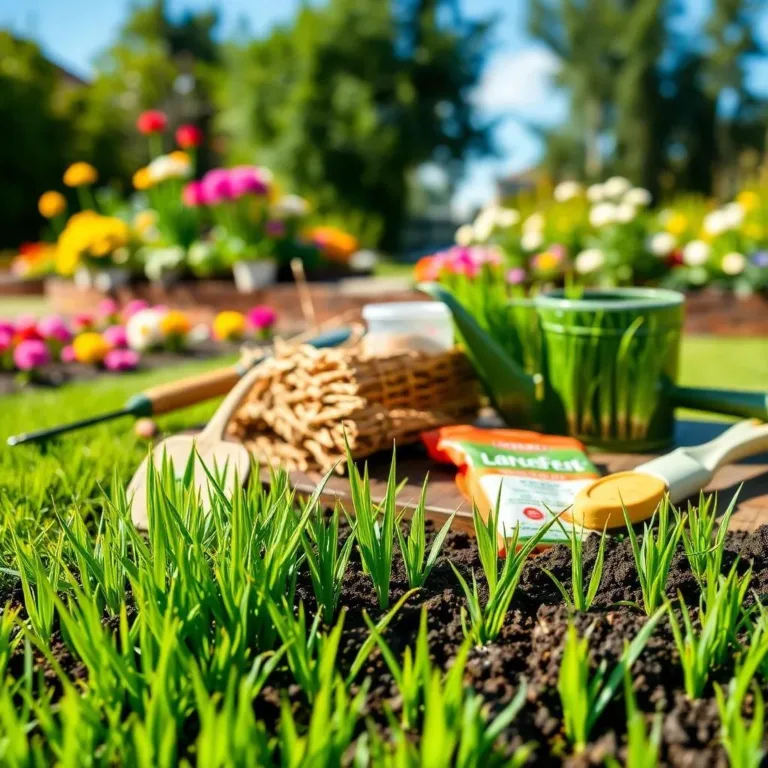Are you ready to transform your lawn into a lush, green paradise? I’m here to share everything you need to know about planting grass seed after using weed killer! From understanding the types of herbicides to learning how to prepare your soil, I’ll help you set up your garden for success. Let’s dig in and get started!
Understanding Different Types of Weed Killers
When it comes to keeping our lawns looking their best, weed killers (or herbicides) can really be a gardener’s best friend! But not all weed killers are created equal, and it’s a good idea to know what you’re working with before planting any grass seed. Let’s break down the main types of weed killers that you might encounter:
- Non-Selective Weed Killers
These bad boys are the heavy hitters of the weed control world! They kill all vegetation they touch, which means they’re super effective but can also be a bit dangerous if you’re not careful. If you accidentally spray them on your prized flower bed, it might turn into a sad story. Common ingredients include glyphosate, and it’s best to wait at least 7 to 14 days after using these before planting grass seed.
- Selective Weed Killers
Now, these are my favorites! Selective weed killers target specific types of plants, usually broadleaf weeds, while leaving your grass unharmed. They usually break down more quickly than non-selective ones, so you might only need to wait around 2 to 3 weeks before planting! Isn’t that great? Just make sure to read the labels to know which weeds they tackle.
- Pre-emergent Herbicides
These guys are the prevention squad! They stop weeds from sprouting in the first place. However, they might take a bit of time to break down, and planting grass seed too soon can lead to disaster. If you use a pre-emergent, plan on waiting a good 8 to 12 weeks before planting your grass seed.
Understanding these types can really help us make informed choices. Remember, being friends with weed killers means respecting their power and giving them time to do their job before we dive into planting grass seed!
Factors Influencing Wait Time for Grass Seed Planting
Now that we’ve got the scoop on the various weed killers, let’s talk about what can affect how long we should wait before planting our grass seed. Trust me, waiting can feel like watching paint dry, but it’s totally worth it for a lush lawn! Here are some big factors to think about:
- Type of Weed Killer: As we just covered, the kind of herbicide you use is super important. Non-selective products linger longer, waiting a week or two is key! Selective ones let us plant sooner, usually within a few weeks.
- Soil Condition: If your soil is compacted or lacking nutrients, the herbicides might take longer to break down. Giving it extra time and loosening up the soil can lead to better results!
- Climate: Yes, Mother Nature has a say in this too! Warmer temperatures can speed up the breakdown of chemicals in the soil. So keep an eye on that weather forecast. Waiting a week during a cooler spell might be a good call.
- Grass Type: Did you know that different grass types react differently to herbicides? Some are tougher than others, so you should check which seed will thrive in your area and plan accordingly!
- Severity of Weed Infestation: If you had a lawn full of weeds, it’s wise to wait until they’re effectively gone. We don’t want any competing weeds to steal the spotlight from our new grass.
By thinking about these factors, we can make smarter choices about when to plant grass seed. Being patient might be tough, but your lawn will thank you later! Remember, good things come to those who wait!

Recommended Wait Times for Various Herbicides
Deciding when to plant grass seed after using different types of herbicides can be a head-scratcher. Don’t worry, I’m here to simplify it for you! Each type of weed killer has its own rules about how long we should wait before sprinkling down those grass seeds, so let’s break it down:
- Non-Selective Weed Killers:
These powerful poisons don’t discriminate; they kill everything in sight! If you use a non-selective weed killer like glyphosate, it’s best to wait at least 7 to 14 days before planting grass seed. This gives the chemicals time to break down and reduces the risk of harming your new grass.
- Selective Weed Killers:
If you’re targeting specific weeds without harming your grass, then a selective weed killer is your best buddy! Generally, you should wait about 2 to 3 weeks after applying these before planting grass seed. But remember, the label will always be your friend, so check it for any specific wait times!
- Pre-emergent Herbicides:
These herbicides prevent weed seeds from sprouting, but they can be tricky when it comes to planting grasses. You’ll want to wait around 8 to 12 weeks after using a pre-emergent before putting down any grass seed. It feels like forever, but it’s worth it for a weed-free lawn!
By keeping these timelines in mind, we can make sure we’re giving our new grass the best chance to grow strong and healthy! Remember, patience is key, and the wait will pay off with a beautiful lawn!
Preparing Soil for Grass Seed After Weed Killer
So, you’ve waited out the recommended time after applying your weed killer. Great job! Now it’s time for the fun part—preparing the soil for planting grass seed! Taking a little extra time here can make a big difference. Ready to dig in? Let’s get started!
- Remove Any Remaining Weeds:
Before you start planting, make sure your soil is weed-free. Pull out any stubborn weeds or leftover grass. These little rivals might sneak in and compete with your new grass, and we can’t have that!
- Loosen the Soil:
If the soil is compacted, grass roots will struggle to grow. Use a garden fork or aerator to loosen it up. Breaking up the soil allows air, water, and nutrients to reach those tiny grass seeds. You want your soil to have a fluffy texture, as it helps our grass grow strong!
- Test the Soil:
A soil test might sound fancy, but it’s easy and super helpful! Testing can tell you if your soil needs any amendments, like lime or fertilizer. This way, your grass will have all the nutrients it needs to thrive.
- Clear Debris:
Make sure your planting area is clear of any rocks, sticks, and debris. We want a clean canvas for our grass, just like a chef wants a clean countertop when whipping up a meal!
- Level the Surface:
Gently rake the soil to level the surface. This helps the grass seeds get an even start, which can help with uniform growth. Plus, it just looks nice!
Taking these steps will set you and your grass seeds up for success! A little preparation goes a long way in growing a thriving lawn. I can’t wait to see your yard flourish!
Tips for Successful Grass Seed Germination After Herbicide Use
Now that you’ve prepped your soil, it’s time to talk about how to give your grass seed the best start possible! Here are some tips that I swear by for successful germination after using herbicides:
- Choose the Right Grass Seed:
Selecting the correct type of grass for your region is key! Look for seed that’s suited to your climate and sunlight conditions. Whether you want a lush green lawn or a drought-resistant turf, the right seeds will make all the difference!
- Follow Seed Rates:
Don’t go wild with the seed; follow the recommended seeding rate on the package. Overcrowding can lead to competition for nutrients and water, creating a lawn that’s less than ideal. Better safe than sorry!
- Water Wisely:
Keep the soil consistently moist after planting, but avoid making it muddy. Light, frequent watering is the name of the game! A gentle spray from the hose can help keep those seeds happy.
- Protect the Area:
If you have pets or kids, consider marking off the area where you’ve planted the seeds. You don’t want them trampling on your fresh lawn! A simple garden border or some stakes can work wonders.
- Watch for Weeds:
Weeds can be sneaky! Keep an eye out for any that might try to invade your newly seeded area. If you spot any, pull them out by hand to give your grass a fighting chance.
- Be Patient:
Finally, the best tip is to have patience! Grass seeds take time to germinate and establish roots. Try not to rush the process, and keep your enthusiasm high as you wait for that beautiful green carpet to sprout!
By following these tips, you’re setting the stage for a gorgeous lawn. So, get ready to kick back and enjoy the fruits of your labor—your future lawn will be the envy of the neighborhood!

